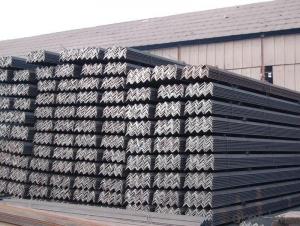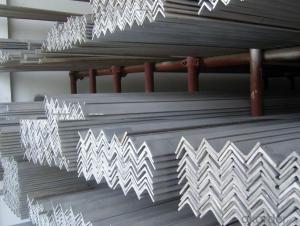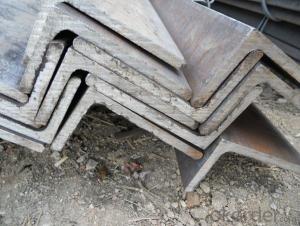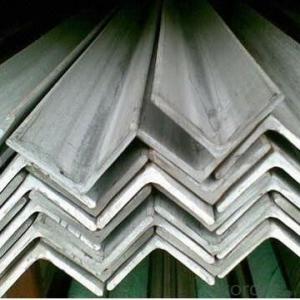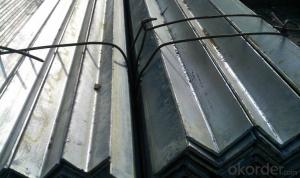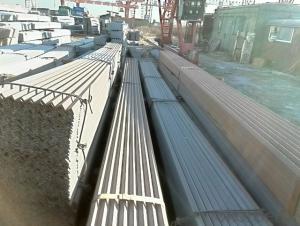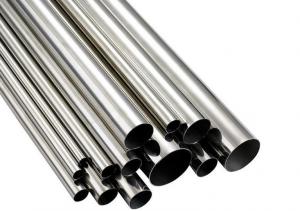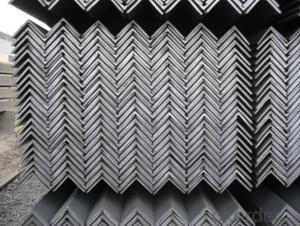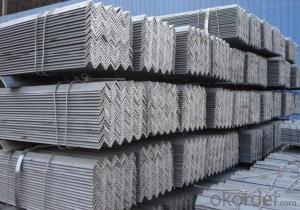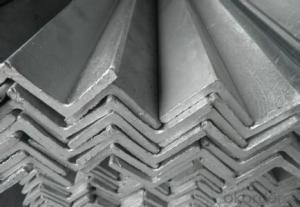Angle Steel Hot Rolled High Quality ASTM Or GB Standard
- Loading Port:
- Tianjin
- Payment Terms:
- TT OR LC
- Min Order Qty:
- 25 m.t.
- Supply Capability:
- 20000000 m.t./month
OKorder Service Pledge
OKorder Financial Service
You Might Also Like
Specification
Product Description:
OKorder is offering Angle Steel Hot Rolled High Quality ASTM Or GB Standard at great prices with worldwide shipping. Our supplier is a world-class manufacturer of steel, with our products utilized the world over. OKorder annually supplies products to European, North American and Asian markets. We provide quotations within 24 hours of receiving an inquiry and guarantee competitive prices.
Product Applications:
According to the needs of different structures, Angle can compose to different force support component, and also can be the connections between components. It is widely used in various building structures and engineering structures such as roof beams, bridges, transmission towers, hoisting machinery and transport machinery, ships, industrial furnaces, reaction tower, container frame and warehouse etc
Product Advantages:
OKorder's SteelAngle Steel Hot Rolled High Quality ASTM Or GB Standard are durable, strong, and resist corrosion.
Main Product Features:
· Premium quality
· Prompt delivery & seaworthy packing (30 days after receiving deposit)
· Corrosion resistance
· Can be recycled and reused
· Mill test certification
· Professional Service
· Competitive pricing
Product Specifications:
Manufacture: Hot rolled
Grade: Q195 – 235
Certificates: ISO, SGS, BV, CIQ
Length: 6m – 12m, as per customer request
Packaging: Export packing, nude packing, bundled
Sizes: 25mm-250mm | ||||||||||||
a*t | ||||||||||||
25*2.5-4.0 | 70*6.0-9.0 | 130*9.0-15 | ||||||||||
30*2.5-6.6 | 75*6.0-9.0 | 140*10-14 | ||||||||||
36*3.0-5.0 | 80*5.0-10 | 150*10-20 | ||||||||||
38*2.3-6.0 | 90*7.0-10 | 160*10-16 | ||||||||||
40*3.0-5.0 | 100*6.0-12 | 175*12-15 | ||||||||||
45*4.0-6.0 | 110*8.0-10 | 180*12-18 | ||||||||||
50*4.0-6.0 | 120*6.0-15 | 200*14-25 | ||||||||||
60*4.0-8.0 | 125*8.0-14 | 250*25 | ||||||||||
FAQ:
Q1: How do we guarantee the quality of our products?
A1: We have established an advanced quality management system which conducts strict quality tests at every step, from raw materials to the final product. At the same time, we provide extensive follow-up service assurances as required.
Q2: How soon can we receive the product after purchase?
A2: Within three days of placing an order, we will begin production. The specific shipping date is dependent upon international and government factors, but is typically 7 to 10 workdays.
Q3: What makes stainless steel stainless?
A3: Stainless steel must contain at least 10.5 % chromium. It is this element that reacts with the oxygen in the air to form a complex chrome-oxide surface layer that is invisible but strong enough to prevent further oxygen from "staining" (rusting) the surface. Higher levels of chromium and the addition of other alloying elements such as nickel and molybdenum enhance this surface layer and improve the corrosion resistance of the stainless material.
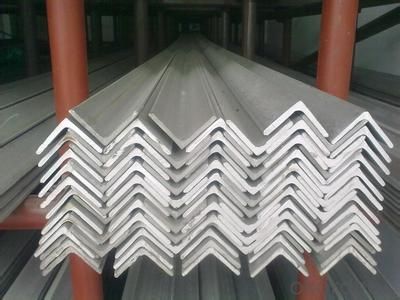
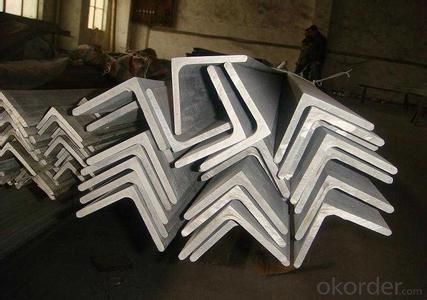
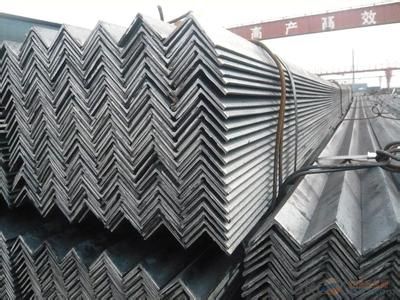
- Q: Are there any special considerations when handling or installing steel angles?
- When handling or installing steel angles, there are several special considerations that need to be taken into account. To begin with, it is crucial to store and transport the angles correctly in order to prevent any damage. To avoid rusting, make sure to store the steel angles in a dry and well-ventilated area. When transporting them, ensure that they are properly secured to prevent accidents or injuries. Next, it is essential to install the steel angles on a solid and level surface to guarantee stability and proper distribution of the load. For accurate installation, it is recommended to use a level and plumb line. Furthermore, it is of utmost importance to use the appropriate size and type of fasteners when installing steel angles. The fasteners must be compatible with both the angle and the material it is being attached to. Additionally, ensure that the fasteners are tightened properly to avoid any loosening or failure. Moreover, the load-bearing capacity of the steel angles should be carefully considered. Select angles based on the expected load and the requirements of the application. It is advisable to consult with a structural engineer or a professional to determine the suitable size and type of steel angles for your specific project. Lastly, maintain safety precautions when handling and installing steel angles. Wear protective gear, such as gloves and safety glasses, to prevent injuries. Additionally, follow safe lifting practices and use appropriate lifting equipment for heavy steel angles. In conclusion, it is important to give due consideration to these special factors when handling or installing steel angles to ensure proper installation, structural integrity, and safety.
- Q: How are steel angles protected against impact damage?
- Steel angles can be protected against impact damage through various methods. One common approach is to use impact-resistant coatings or paints that are specifically designed to absorb and distribute the force of an impact, thereby minimizing the damage caused. These coatings can be applied to the surface of the steel angles, providing an additional layer of protection. Another method is to use rubber or plastic bumper guards, which can be attached to the edges or corners of the steel angles. These guards act as a buffer, absorbing the impact energy and preventing direct contact between the steel angle and the object causing the impact. This helps to reduce the risk of denting or deformation. In some cases, steel angles may be reinforced with additional structural elements, such as bracing or stiffeners, to enhance their resistance to impact damage. These reinforcements can help distribute the force of an impact more evenly across the structure, reducing the risk of localized damage. Furthermore, proper installation and maintenance practices play a crucial role in protecting steel angles against impact damage. Ensuring that the angles are securely fastened and regularly inspected for any signs of wear or damage can help identify potential issues before they escalate. Overall, a combination of impact-resistant coatings, bumper guards, structural reinforcements, and diligent maintenance can effectively protect steel angles against impact damage, prolonging their lifespan and ensuring their structural integrity.
- Q: Can steel angles be used in mining or quarrying machinery?
- Yes, steel angles can be used in mining or quarrying machinery. Steel angles provide structural support and reinforcement to various components of machinery used in these industries. They are commonly used in the construction of frames, supports, and brackets for equipment such as crushers, conveyors, and screens. The high strength and durability of steel angles make them suitable for withstanding the heavy loads, vibrations, and harsh operating conditions typically encountered in mining or quarrying operations. Additionally, steel angles can be easily fabricated and welded to meet specific design requirements, making them a versatile choice for machinery applications in these industries.
- Q: What are the different specifications for steel angles?
- The different specifications for steel angles include the dimensions (length, width, and thickness), the weight per foot, the shape of the angle (equal or unequal leg), the type of steel used (such as carbon steel or stainless steel), and any additional features or finishes required (such as galvanized or painted).
- Q: Can steel angles be used for sign or billboard support structures?
- Yes, steel angles can be used for sign or billboard support structures. Steel angles are often used in construction projects because of their strength and durability. They provide excellent support for various structures, including sign or billboard installations. Steel angles are versatile and can be easily fabricated and installed to meet the specific requirements of the signage or billboard. They are capable of withstanding heavy loads and adverse weather conditions, making them an ideal choice for supporting these structures. Additionally, steel angles can be painted or coated to enhance their appearance and protect them from corrosion, further extending their lifespan.
- Q: How do steel angles perform under cyclic or alternating loading conditions?
- Steel angles possess excellent performance characteristics under cyclic or alternating loading conditions because of their structural properties. The durability and high strength of steel are renowned, enabling angles to endure repeated loading without significant deformation or failure. Fatigue, a phenomenon that transpires when a material experiences recurring stress cycles, is observed in steel angles under cyclic loading. This leads to the accumulation of damage and potential failure over time. Nevertheless, steel has an exceptional fatigue strength compared to other materials, rendering it highly resistant to fatigue-induced failure. The performance of steel angles under cyclic loading is also influenced by their distinctive shape. The L-shaped configuration adds to their stability and ability to withstand bending or twisting forces. This form facilitates the dispersion of the load more evenly along the angle's length, reducing stress concentrations and enhancing its fatigue life. Moreover, steel angles can be reinforced using diverse techniques, such as heat treatment or surface hardening. These processes enhance the material's resistance to cyclic loading, making it even more proficient in enduring repeated stress cycles. In summary, steel angles are ideal for cyclic or alternating loading conditions due to their remarkable strength, durability, and fatigue resistance. Their L-shaped design and potential for reinforcement make them dependable structural components in various fields, encompassing construction, engineering, and manufacturing.
- Q: What are the common applications of steel angles in architecture?
- Steel angles are widely used in architecture for various applications due to their versatility and strength. Some common applications of steel angles in architecture include: 1. Structural support: Steel angles are often used as structural support elements in building construction. They can be welded or bolted together to form a sturdy framework that provides strength and stability to the structure. 2. Framing: Steel angles are commonly used in framing applications such as door and window frames, as well as in the construction of roof trusses. They provide rigidity and support to the overall structure, ensuring that it remains stable and durable. 3. Reinforcement: Steel angles are often used to reinforce concrete structures. They can be embedded into concrete walls, columns, and beams to enhance their load-bearing capacity and resistance to deformation. 4. Staircases and handrails: Steel angles are frequently used in the construction of staircases and handrails. They provide a strong and durable framework that ensures the safety and stability of these architectural elements. 5. Architectural detailing: Steel angles are also utilized for architectural detailing purposes. They can be used to create decorative elements such as cornices, brackets, and ornamental features that add aesthetic appeal to the building. 6. Industrial applications: Steel angles find application in industrial settings, such as factories and warehouses, where they are used to create sturdy platforms, mezzanines, and equipment supports. Overall, steel angles are a versatile and reliable material that offers numerous benefits for architectural applications. Their strength, durability, and flexibility make them an ideal choice for a wide range of architectural structures and features.
- Q: What are the different methods for fastening steel angles?
- Fastening steel angles can be done in several ways, depending on the specific application and load requirements. Some commonly used methods include the following: 1. Bolting: Bolting is a popular method for securing steel angles. It involves using bolts, washers, and nuts to attach the angle to a structure or another piece of steel. This method provides a strong and dependable connection, especially when the bolts are tightened to the correct torque specification. 2. Welding: Welding is another commonly employed technique for fastening steel angles, particularly when a permanent and sturdy connection is necessary. It entails melting the base metal and the angle together to form a robust joint. Various welding techniques, such as arc welding, MIG welding, or TIG welding, can be utilized. 3. Riveting: Riveting is a method that involves using rivets to join steel angles together or to other components. This approach creates a secure and durable connection, especially in situations where there may be vibration or movement. Riveting requires drilling holes in the steel angles and using a rivet gun to insert the rivets through the holes. 4. Adhesive bonding: Adhesive bonding can be employed in certain applications to fasten steel angles. This method involves applying a high-strength adhesive or epoxy between the angle and the surface to which it is being attached. Adhesive bonding offers a clean and visually appealing connection while also evenly distributing loads across the joint. 5. Clamping: Clamping is a temporary method used to hold steel angles in place during assembly or construction. It involves using clamps or brackets until a more permanent fastening method, such as bolting or welding, can be applied. Each method has its own advantages and disadvantages, and the choice depends on factors such as load requirements, structural design, cost, and the need for disassembly or adjustability. Selecting the appropriate fastening method is crucial to ensure the safety and integrity of the steel angles in their intended application.
- Q: Which is cheaper, angle iron or steel pipe?
- Steel tube (Steel pipe) production technology development began in the bicycle manufacturing industry, the rise of the early nineteenth Century during the oil development, the two world war ships, boilers, aircraft manufacturing, manufacturing of power boiler after the Second World War, the development of chemical industry of petroleum and natural gas drilling and transportation, will effectively promote the the yield and quality of varieties, the development of steel tube industry.
- Q: How do steel angles contribute to LEED certification?
- There are several ways in which the use of steel angles can contribute to LEED certification, which is the Leadership in Energy and Environmental Design. Firstly, the production of steel angles often involves the use of recycled steel, reducing the need for new materials and lessening the environmental impact of steel production. Secondly, steel angles have a long lifespan and are highly durable, resulting in reduced maintenance and replacement needs. This, in turn, leads to a decrease in waste generated throughout a building's lifecycle, thus earning LEED credits for minimizing construction and demolition waste. Furthermore, steel angles can be utilized to create efficient structural systems that allow for open and adaptable building designs. This aspect qualifies for LEED recognition in the Innovation in Design category, highlighting exceptional energy and resource efficiency. Additionally, integrating steel angles into a building's design is a straightforward process, making it easier to support sustainable features like solar panels, green roofs, or rainwater harvesting systems. These environmentally friendly features are instrumental in achieving LEED credits for energy efficiency, renewable energy, and water efficiency. In conclusion, the utilization of steel angles in construction contributes to LEED certification through their use of recycled materials, provision of durability and longevity, facilitation of efficient structural systems, and support for sustainable features integration.
Send your message to us
Angle Steel Hot Rolled High Quality ASTM Or GB Standard
- Loading Port:
- Tianjin
- Payment Terms:
- TT OR LC
- Min Order Qty:
- 25 m.t.
- Supply Capability:
- 20000000 m.t./month
OKorder Service Pledge
OKorder Financial Service
Similar products
Hot products
Hot Searches
Related keywords
